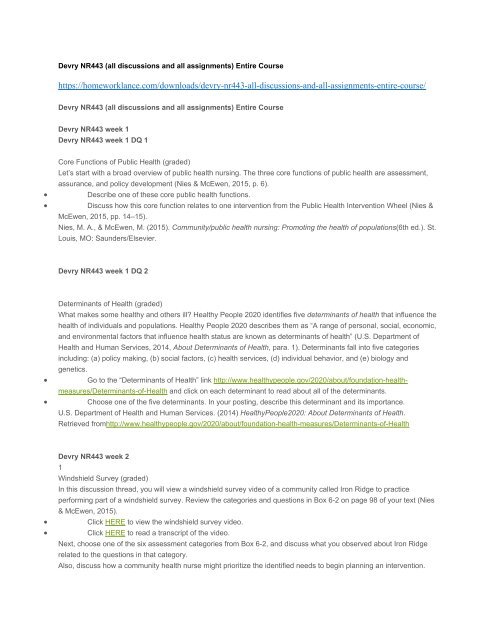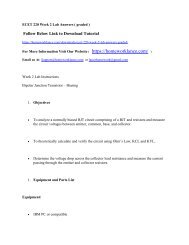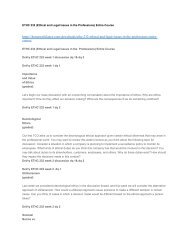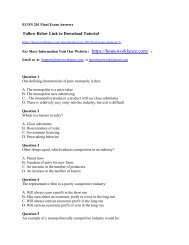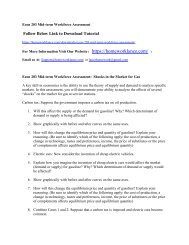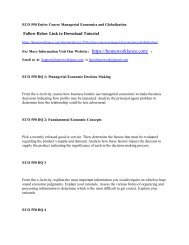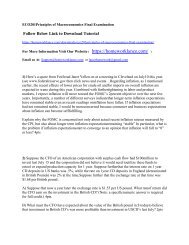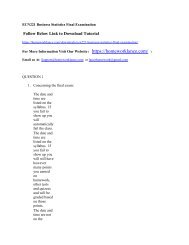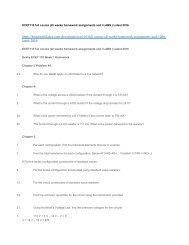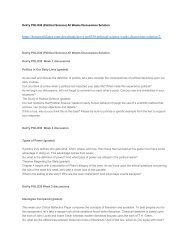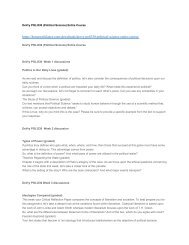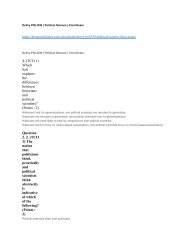Devry NR443 (all discussions and all assignments) Entire Course
Create successful ePaper yourself
Turn your PDF publications into a flip-book with our unique Google optimized e-Paper software.
<strong>Devry</strong> <strong>NR443</strong> (<strong>all</strong> <strong>discussions</strong> <strong>and</strong> <strong>all</strong> <strong>assignments</strong>) <strong>Entire</strong> <strong>Course</strong><br />
https://homeworklance.com/downloads/devry-nr443-<strong>all</strong>-<strong>discussions</strong>-<strong>and</strong>-<strong>all</strong>-<strong>assignments</strong>-entire-course/<br />
<strong>Devry</strong> <strong>NR443</strong> (<strong>all</strong> <strong>discussions</strong> <strong>and</strong> <strong>all</strong> <strong>assignments</strong>) <strong>Entire</strong> <strong>Course</strong><br />
<strong>Devry</strong> <strong>NR443</strong> week 1<br />
<strong>Devry</strong> <strong>NR443</strong> week 1 DQ 1<br />
<br />
<br />
Core Functions of Public Health (graded)<br />
Let’s start with a broad overview of public health nursing. The three core functions of public health are assessment,<br />
assurance, <strong>and</strong> policy development (Nies & McEwen, 2015, p. 6).<br />
Describe one of these core public health functions.<br />
Discuss how this core function relates to one intervention from the Public Health Intervention Wheel (Nies &<br />
McEwen, 2015, pp. 14–15).<br />
Nies, M. A., & McEwen, M. (2015). Community/public health nursing: Promoting the health of populations(6th ed.). St.<br />
Louis, MO: Saunders/Elsevier.<br />
<strong>Devry</strong> <strong>NR443</strong> week 1 DQ 2<br />
<br />
<br />
Determinants of Health (graded)<br />
What makes some healthy <strong>and</strong> others ill? Healthy People 2020 identifies five determinants of health that influence the<br />
health of individuals <strong>and</strong> populations. Healthy People 2020 describes them as “A range of personal, social, economic,<br />
<strong>and</strong> environmental factors that influence health status are known as determinants of health” (U.S. Department of<br />
Health <strong>and</strong> Human Services, 2014, About Determinants of Health, para. 1). Determinants f<strong>all</strong> into five categories<br />
including: (a) policy making, (b) social factors, (c) health services, (d) individual behavior, <strong>and</strong> (e) biology <strong>and</strong><br />
genetics.<br />
Go to the “Determinants of Health” link http://www.healthypeople.gov/2020/about/foundation-healthmeasures/Determinants-of-Health<br />
<strong>and</strong> click on each determinant to read about <strong>all</strong> of the determinants.<br />
Choose one of the five determinants. In your posting, describe this determinant <strong>and</strong> its importance.<br />
U.S. Department of Health <strong>and</strong> Human Services. (2014) HealthyPeople2020: About Determinants of Health.<br />
Retrieved fromhttp://www.healthypeople.gov/2020/about/foundation-health-measures/Determinants-of-Health<br />
<br />
<br />
<strong>Devry</strong> <strong>NR443</strong> week 2<br />
1<br />
Windshield Survey (graded)<br />
In this discussion thread, you will view a windshield survey video of a community c<strong>all</strong>ed Iron Ridge to practice<br />
performing part of a windshield survey. Review the categories <strong>and</strong> questions in Box 6-2 on page 98 of your text (Nies<br />
& McEwen, 2015).<br />
Click HERE to view the windshield survey video.<br />
Click HERE to read a transcript of the video.<br />
Next, choose one of the six assessment categories from Box 6-2, <strong>and</strong> discuss what you observed about Iron Ridge<br />
related to the questions in that category.<br />
Also, discuss how a community health nurse might prioritize the identified needs to begin planning an intervention.
Nies, M. A., & McEwen, M. (2015). Community/Public health nursing: Promoting the health of populations(6th ed.).<br />
St. Louis, MO: Saunders/Elsevier<br />
<strong>Devry</strong> <strong>NR443</strong> week 2 DQ 2<br />
Demographic <strong>and</strong> Epidemiological Assessment (graded)<br />
For this post, you will collect assessment data about your city or county. This post will include information about<br />
demographics (general characteristics) <strong>and</strong> epidemiological data (disease or health behavior rates) of your<br />
community. This data collection will help with two sections of your Week 4 Milestone 2 assignment.<br />
1. Demographic data: Go online to the U.S. Census Bureau at http://quickfacts.census.gov/. Obtain information<br />
about the demographic characteristics of the population for your city or county of residence. You may have to look at<br />
county data if your city is not listed. Collect a range of demographic data about age, ethnicity, poverty levels, housing,<br />
<strong>and</strong> education.<br />
2. Epidemiological data: Go to your city or county health department website (search the Internet) or County<br />
Health Rankings (http://www.countyhealthrankings.org/) to discuss epidemiological data about your area. Identify<br />
several priority health concerns for your area.<br />
Here is a helpful tip sheet about the<br />
<strong>Devry</strong> <strong>NR443</strong> week 3<br />
DQ 1<br />
Caring for Vulnerable Populations (graded)<br />
This week, you are learning about many different vulnerable populations. Choose one vulnerable population.<br />
<br />
Briefly describe this vulnerable population.<br />
<br />
Discuss several risk factors that may impact health outcomes for this group.<br />
<br />
Describe two priorities for community health nurses working with this population.<br />
DQ 2<br />
<br />
<br />
Assuring Resources for the Vulnerable (graded)<br />
Review the Week 3 Case Study that may be found in Doc Sharing.<br />
Assurance is one of the three core functions of public health. Find a resource in your community (other than WIC)<br />
that could assist Mary during her pregnancy. Start by searching the Internet for your local health department’s<br />
website. What services do they provide for pregnant women or those with mental health concerns? What about your<br />
local welfare office? Do they provide prenatal or mental health services? Are there any service organizations, crisis<br />
pregnancy centers, or churches providing help for pregnant women or those experiencing mental health concerns?<br />
Briefly describe the types of services that you found.<br />
Choose one agency <strong>and</strong> assess this agency in terms of the 4 As. Is it accessible, acceptable, affordable, or<br />
available for Mary or other pregnant women that you case-manage?<br />
<strong>Devry</strong> <strong>NR443</strong> week 4<br />
DQ 1<br />
Concerns for the School Nurse (graded)<br />
As the school nurse role evolves, there are increasingly more health concerns for the school nurse. Does the locale<br />
make a difference in the problems, or are health problems in children <strong>and</strong> adolescents universal? In some inner-city<br />
areas, violence is a prevalent issue. What do you think are the biggest problems in your areas?
DQ 2<br />
Healthy People Objectives for Community Settings (graded)<br />
The federal government developed Healthy People as a set of national health objectives that are revised every 10<br />
years. These objectives are very specific in order to guide <strong>and</strong> measure our nation’s progress related to public health.<br />
Please visit http://www.healthypeople.gov/2020/topicsobjectives2020/. Click on a topic area that relates to a<br />
community health (CH) setting you are learning about. Click on the green Objectives area in that topic area to choose<br />
one Healthy People 2020 numbered objective.<br />
Describe the community health setting of interest (see Chapters 30–33).<br />
<br />
Discuss one specific numbered Healthy People 2020 objective (not a goal) related to this community health<br />
<br />
setting.<br />
How could a community health nurse help this setting meet this objective?<br />
Here is a helpful “Introduction to Healthy People 2020 website” document to aid you in navigating the HP 2020<br />
website.<br />
U.S. Department of Health <strong>and</strong> Human Services. (2014). Healthy People 2020: 2020 Topics & Objectives. Retrieved<br />
from http://www.healthypeople.gov/2020/topicsobjectives2020/<br />
<strong>Devry</strong> <strong>NR443</strong> week 5<br />
DQ 1<br />
<br />
<br />
Population Health Intervention Strategies (graded)<br />
Review the Week 5 Case Study found in Doc Sharing.<br />
You will continue in your role as a nurse with your local health department. Examine your online lesson, assigned<br />
readings, <strong>and</strong> visit The Community Guide website:http://www.thecommunityguide.org/ to explore interventions related<br />
to violence or excess alcohol use. Choose one evidence-based intervention that is recommended, <strong>and</strong> present this<br />
intervention to the task force.<br />
Summarize this intervention <strong>and</strong> <strong>and</strong> discuss the community health nurse’s role in implementing this<br />
strategy.<br />
Describe whether it is considered a primary, secondary, or tertiary prevention strategy <strong>and</strong> include your<br />
rationale (see Nies & McEwen, 2015, Chapter 1, p. 7 for a review of levels of prevention).<br />
Community Preventive Services Task Force. (2014). The Community Guide. Retrieved<br />
fromhttp://www.thecommunityguide.org/<br />
Nies, M. A., & McEwen, M. (2015). Community/Public health nursing: Promoting the health of populations(6th ed.).<br />
St. Louis, MO: Saunders/Elsevier.<br />
DQ 2<br />
<br />
<br />
Disaster <strong>and</strong> Communicable Disease Preparedness (graded)<br />
Preparing for disasters or communicable disease outbreaks is an important part of public health nursing. Visit the<br />
websitehttp://www.ready.gov<strong>and</strong> http://www.ready.gov/p<strong>and</strong>emic. Review the steps for being prepared for a disaster<br />
or p<strong>and</strong>emic.<br />
As a community health nurse, what elements do you think are important to stress to the community?<br />
How well is your community prepared for a potential outbreak or disaster?<br />
Federal Emergency Management Agency. (2014). Ready: Prepare. Plan. Stay Informed.Retrieved<br />
fromhttp://www.ready.gov/
Federal Emergency Management Agency. (2014). P<strong>and</strong>emic.Retrieved from<br />
http://www.ready.gov/p<strong>and</strong>emic<br />
<strong>Devry</strong> <strong>NR443</strong> week 6<br />
<br />
<br />
Affordable Care Act (ACA) (graded)<br />
Please explore the healthcare marketplace website at https://www.healthcare.gov/. Choose the get answers tab<br />
towards the top of the page. Review several of the topics under this tab <strong>and</strong> share something that you learned about<br />
how the marketplace works <strong>and</strong> how this would apply to those in your community.<br />
The Affordable Care Act is a controversial topic, <strong>and</strong> I’m sure there are many different viewpoints represented in our<br />
class. For this discussion, let’s focus on underst<strong>and</strong>ing the basics of the marketplace so that we can provide accurate<br />
information for our patients <strong>and</strong> communities.<br />
<strong>Devry</strong> <strong>NR443</strong> week 1 DQ 2<br />
Environmental Health (graded)<br />
Visit the U.S. Environmental Protection Agency’s MyEnvironment site<br />
athttp://www.epa.gov/myenvironment/howUsePage.html. Review the site overview <strong>and</strong> enter your city, zip code, or<br />
location into the MyEnvironment box. Explore the site to learn more about your environment <strong>and</strong> things that might be<br />
impacting the health of its citizens.<br />
Identify something new you learned about your environment <strong>and</strong> how it could be affecting health by<br />
completing this statement, “I didn’t know _____.”<br />
How could you, in the role of a community health nurse, address these concerns?<br />
<strong>Devry</strong> <strong>NR443</strong> week 7<br />
<br />
<br />
<br />
<br />
This week, you were assigned to read <strong>and</strong> review Recommendation 8 of IOM’s Future of Nursing Recommendations.<br />
Recommendation #8 states:Build an infrastructure for the collection <strong>and</strong> analysis of interprofessional healthcare<br />
workforce data.<br />
Visit http://thefutureofnursing.org/recommendation/detail/recommendation-8<br />
Consider the problem you identified in your Caring for Populations Milestone. How could collaboration be<br />
improved to enhance outcomes?<br />
The Institute of Medicine. (2010). The future of nursing leading change, advancing health: Recommendation 8.<br />
Retrieved fromhttp://thefutureofnursing.org/recommendation/detail/recommendation-8<br />
Ethics <strong>and</strong> Diversity (graded)<br />
Review the Week 7 Case Study found in Doc Sharing.<br />
You will continue in your role as a nurse with your local health department. As part of the health department’s “Think<br />
Cultural Health” seminar, each team member will discuss oneof the 15 National Cultural <strong>and</strong> Linguistic<strong>all</strong>y<br />
Appropriate Services (CLAS) st<strong>and</strong>ards. Visithttps://www.thinkculturalhealth.hhs.gov/Content/clas.asp. Browse the<br />
site <strong>and</strong> click on the link to open the list of the National CLAS St<strong>and</strong>ards.<br />
Describe one National CLAS St<strong>and</strong>ard.<br />
Discuss one way that you could implement this st<strong>and</strong>ard for a specific cultural group in your community.<br />
Office of Minority Health, Department of Health <strong>and</strong> Human Services. (2013). National st<strong>and</strong>ards for cultur<strong>all</strong>y <strong>and</strong><br />
linguistic<strong>all</strong>y appropriate services in health <strong>and</strong> health care: a blueprint for advancing <strong>and</strong> sustaining CLAS policy <strong>and</strong><br />
practice. Retrieved fromhttps://www.thinkculturalhealth.hhs.gov/Content/clas.asp<br />
<strong>Devry</strong> <strong>NR443</strong> week 8
Future Directions (graded)<br />
Reflect on what you have learned in this course. What could you take from it <strong>and</strong> bring into your current<br />
practice? Please share specific examples.<br />
week 2<br />
Caring for Populations: Milestone1: Community Windshield Survey Form<br />
Directions: Please refer to the Milestone 1: Community Windshield Survey Guidelines <strong>and</strong> grading rubric for specific<br />
instructions in order to complete the information below. This assignment is worth 150 points.<br />
Type your name, date, <strong>and</strong> observations directly on this form. Click Save as <strong>and</strong> save the file with the assignment<br />
name <strong>and</strong> your last name; for example, <strong>NR443</strong> Windshield Survey Form_Smith. When you are finished, submit the<br />
form to the Week 2 Caring for Populations: Windshield Survey Dropbox by the deadline indicated in your guidelines.<br />
YourName: Date:<br />
Your<br />
Criteria<br />
response<br />
1. Introduction<br />
of Community<br />
(20 points)<br />
Identify the city<br />
<strong>and</strong> state of your<br />
community <strong>and</strong><br />
briefly describe<br />
the community<br />
you will be using<br />
for this<br />
assignment. It<br />
should be the<br />
area where you<br />
live or the area<br />
surrounding your<br />
work setting but<br />
must include a<br />
residential area.<br />
Demographic<br />
data are not<br />
needed.<br />
2. Windshield<br />
Survey (100<br />
points)<br />
a. Vitality:Use a<br />
majority of the<br />
questions from<br />
Box 6-2 in your<br />
text to describe<br />
your
observations<br />
about the<br />
community<br />
vitality.<br />
b. Indicators of<br />
social <strong>and</strong><br />
economic<br />
conditions:Use<br />
a majority of the<br />
questions from<br />
Box 6-2 in your<br />
text to describe<br />
your<br />
observations<br />
about the social<br />
<strong>and</strong> economic<br />
conditions.<br />
c. Health<br />
Resources:Use<br />
a majority of the<br />
questions from<br />
Box 6-2 in your<br />
text to describe<br />
your<br />
observations<br />
about the health<br />
resources.<br />
d.<br />
Environmental<br />
conditions<br />
related to<br />
health:Use a<br />
majority of the<br />
questions from<br />
Box 6-2 in your<br />
text to describe<br />
your<br />
observations<br />
about the<br />
environmental<br />
conditions.<br />
e. Social<br />
functioning:Use<br />
a majority of the<br />
questions from<br />
Box 6-2 in your<br />
text to describe<br />
your
observations<br />
about the social<br />
functioning.<br />
f. Attitude<br />
toward<br />
healthcare:Use<br />
a majority of the<br />
questions from<br />
Box 6-2 in your<br />
text to describe<br />
your<br />
observations<br />
about the<br />
attitudes toward<br />
healthcare.<br />
3. Conclusion:<br />
(20 pts)<br />
Provide a<br />
summary of your<br />
findings <strong>and</strong> your<br />
conclusion. What<br />
problems did you<br />
identify?<br />
4. References:<br />
optional: List in<br />
APA format any<br />
referencesthat<br />
you used. If you<br />
include any<br />
references here,<br />
you must also<br />
include an in-text<br />
citation (author,<br />
year).<br />
week 4<br />
Guidelines for Caring for PopulationsMilestone 2:<br />
Assessment <strong>and</strong> Diagnosis<br />
Purpose<br />
The purpose of this paper is to provide an opportunity to utilize community assessment strategies, uncover a<br />
community health problem, <strong>and</strong> identify the components of one community health nursing problem related to the<br />
community dynamics.<br />
<strong>Course</strong> Outcomes<br />
This assignment enables the student to meet the following course outcomes.<br />
CO2: Assess the health needs of individuals, families, aggregates, <strong>and</strong> communities using demographic <strong>and</strong><br />
epidemiological data to identify population health risks. (PO 4)<br />
CO6: Utilize a systems-based <strong>and</strong> collaborative approach to address factors that influence the health of a community<br />
<strong>and</strong> population health problems. (PO 2)<br />
Due Date
Submit to the appropriate basket in the Dropboxby 11:59 p.m. MT Sunday of Week 4.<br />
Points:225 points<br />
Directions<br />
<br />
<br />
<br />
<br />
<br />
<br />
<br />
Watch the Milestone 2 tutorialby clicking thislink. This tutorial is also available on <strong>Course</strong> Project page under <strong>Course</strong><br />
Home as well as Week 4 Assignments page.<br />
This paper is expected to be no more than fourpages in length (not including the title page <strong>and</strong> reference list). Below<br />
are the requirements for successful completion of this paper.Please use the following categories as the first level<br />
headings on your paper. See the documents in the APA category in <strong>Course</strong> Resources for assistance with APA<br />
formatting.<br />
[Introduction:]This beginning of your paper should catch the reader’s attention with interesting facts about<br />
your community<strong>and</strong> shouldinclude the purpose statement of the paper. This should be one paragraph.APA states that<br />
you should not title this as introduction; however, you are still expected to write a separate introduction. The title of<br />
the paper should be repeated at the top of page two <strong>and</strong> centered.<br />
Community Overview: Identify the community that you are assessingby name <strong>and</strong> state<strong>and</strong> provide a<br />
generaldescription of the community. What is the general character of the community?Statistics should not be<br />
included here. Your community should be the area you live or workin <strong>and</strong> should include a residential area. It should<br />
be a large enough area to answer the questions in the text. This should be one paragraph.<br />
Demographic Data: Compile a range of demographic (population description) data for your community by<br />
examining U.S. Census Bureau reports. Using this data, describe yourcommunity. Compare your community data to<br />
state or national data. A summary of this data should beno more than two paragraphs.<br />
Epidemiological Data: Compile <strong>and</strong> summarize a range of epidemiological (illness, morbidity, <strong>and</strong><br />
mortality) data for your community by examining data from sources such as city or county health department reports,<br />
County Health Rankings (countyhealthrankings.org), or the Centers for Disease Control to describe priority health<br />
problems in your area. See the Webliography for applicable sites to search. Compare your community to state or<br />
national data. This comparison will help to identify a priority community health problem specific to your community. A<br />
summary of this data should be no more than two paragraphs.<br />
Windshield Survey: Provide a summary of your observationsfrom your first milestone. Make sure to<br />
discuss observations related to your identified problem. This should be one to two paragraphs.<br />
Problem Diagnosis:<br />
o Using the assessment data, identify one community health nursing problem that you consider to be a priority<br />
concern.<br />
o Relate your choice to one of the Healthy People 2020specific numbered objectives (not just a goal).Healthy<br />
People objectives are located within a topic area under the Objectives tab.<br />
o Your rationale should also include why this is a problem in your community <strong>and</strong> factors that contribute to the<br />
problem. Avoid discussion of interventions in this milestone.<br />
o Include a discussion of your problem withinformation from at least two scholarly sources (such as professional<br />
journal articles).(Review the documents in the APA category in Doc Sharing for help in determining sources that are<br />
considered scholarly—hint, .com websites are not considered scholarly sources).This should beno more than three<br />
paragraphs.<br />
Summary:Summarize your community assessment <strong>and</strong> diagnosis findings <strong>and</strong> include a brief statement<br />
about the problem<strong>and</strong> the major factors that contribute to this problem. This information should be no more than two<br />
paragraphs.
page.<br />
Reference Page: All references should be cited within the paper<strong>and</strong> should be included on the reference<br />
Guidlines<br />
<br />
<br />
<br />
<br />
<br />
<br />
<br />
Application: Use Microsoft Word 2010 (or later)to create this assignment.<br />
Use the categories above as APA headings for the sections of your paper.<br />
Length: This paper is expected to be no more than four pages in length (not including the title page <strong>and</strong><br />
reference list).<br />
Submission: Submit your file via the basket in the Dropbox: Milestone 2 Assessment <strong>and</strong> Diagnosis, by<br />
11:59 p.m.MT Sunday of Week 4.<br />
Scholarly Writing: APA format is required. Review APA documents in the APA categoryin <strong>Course</strong><br />
Resources<strong>and</strong> use the free resources of SmartThinking for writing tutors.<br />
Save your paper with your last name in the document title (e.g., Smith Assessment <strong>and</strong> Diagnosis).<br />
Late Submission: See the course policy on late submissions.<br />
Best Practicesin Preparing the Paper<br />
<br />
<br />
<br />
<br />
<br />
<br />
<br />
<br />
<br />
The following are best practices in preparing this project.<br />
Complete the demographic, epidemiologic, <strong>and</strong> windshield survey prior to choosing a problem to focus on.<br />
Choose onenursing problem specific to your community.<br />
Make sure <strong>all</strong> elements of the paper are addressed <strong>and</strong> headings for each category are included.<br />
Review directions thoroughly.<br />
Cite <strong>all</strong> sources within the paper as well as on the reference page.<br />
Proofread prior to final submission.<br />
Check for spelling <strong>and</strong> grammar errors prior to final submission.<br />
Use the A column of the rubric below to ensure that you have included <strong>all</strong> the needed elements.<br />
Abide by the CCN academic integrity policy. The paper must be your original work. Once submitted to the<br />
Dropbox, check back to ensure that your Turnitin similarity index is less than 24%, if not revise <strong>and</strong> resubmit prior to<br />
the deadline.<br />
Grading Rubric:Milestone 2: Assessment <strong>and</strong> Diagnosis (225 points)<br />
F<br />
C<br />
A<br />
B<br />
(0–75%)<br />
(76–83%)<br />
(92–100%)<br />
(84–91%)<br />
Poor or failing<br />
Competent or<br />
Criteria Outst<strong>and</strong>ing or Very good or<br />
or<br />
Pts<br />
satisfactory<br />
highest level of high level of<br />
unsatisfactory<br />
level of<br />
performance performance<br />
level of<br />
performance<br />
performance<br />
Includes the purpose of<br />
Missing<br />
the paper <strong>and</strong> catches<br />
Missing purpose Introduction<br />
Introduction<br />
purpose of<br />
the reader’s attention<br />
of paper<strong>and</strong> hook missing /10<br />
10 points<br />
paper orhook<br />
with interesting facts<br />
(7 points) (0–6 points)<br />
(8 points)<br />
(9–10 points)<br />
Community Community identified Community Community Community not /20
Overview<br />
20 points<br />
<strong>and</strong> adequately<br />
described<br />
(18–20 points)<br />
identified but<br />
description is<br />
inadequate<br />
identified but<br />
description is<br />
missing<br />
identified or<br />
described<br />
(0–14 points)<br />
(16 points) (15 points)<br />
Describes a range of<br />
Lacks<br />
Adequate<br />
demographic data<br />
Little<br />
demographic<br />
demographic<br />
about your community<br />
demographic data<br />
Demographic<br />
data described<br />
fromU.S. Census<br />
data <strong>and</strong>missing <strong>and</strong>missing<br />
Data<br />
butmissing<br />
Bureau reports with<br />
state or national state or<br />
30 points<br />
state or national<br />
comparisons to state or<br />
comparisons national<br />
comparison<br />
national data<br />
(23–24 points) comparisons<br />
(25–27 points)<br />
(28–30 points)<br />
(0–22 points)<br />
/30<br />
Describes a range of<br />
Adequate<br />
Lacks<br />
epidemiological data<br />
Little<br />
Epidemiological<br />
epidemiological<br />
epidemiological<br />
about community<br />
epidemiological<br />
Data (Disease<br />
data described<br />
data <strong>and</strong><br />
fromappropriate<br />
data <strong>and</strong> missing<br />
or health<br />
but missing<br />
missing state /30<br />
reports with<br />
state or national<br />
behavior rates)<br />
state or national<br />
or national<br />
comparisons to state or<br />
comparisons<br />
30 points<br />
comparison<br />
comparisons<br />
national data<br />
(23–24 points)<br />
(25–27 points)<br />
(0–22 points)<br />
(28–30 points)<br />
Windshield<br />
Windshield<br />
Survey<br />
20 points<br />
Problem<br />
Diagnosis<br />
40 points<br />
Application of<br />
survey findings Windshield<br />
Community windshield<br />
adequately survey findings<br />
survey findings<br />
Windshield<br />
summarized but not adequately<br />
adequatelysummarized<br />
survey findings<br />
not clearly summarized <strong>and</strong><br />
/20<br />
<strong>and</strong>findings relate to<br />
not described<br />
related to not related to the<br />
identified problem<br />
(0–14 points)<br />
identified problem(15<br />
(18–20 points)<br />
problem points)<br />
(16 points)<br />
Assessment data used<br />
to identify one priority<br />
community<br />
healthproblem, Healthy<br />
Problem not Problem not<br />
People 2020 specific<br />
related to related to Healthy<br />
objective included, <strong>and</strong><br />
Problem<br />
Healthy People People<br />
rationale for problem<br />
discussion<br />
objectiveorlacks objective<strong>and</strong>lacks<br />
/40<br />
selection stated with<br />
missing<br />
rationale with rationale with<br />
supportive data (such<br />
(0–29 points)<br />
supportive data supportive data<br />
as factors that<br />
(34–36 points) (30–33 points)<br />
contribute to this<br />
problem) from two<br />
scholarly articles<br />
(37–40 points)<br />
Two or more quality Two references Only one<br />
Evidence-Based references from discussed, but reference No references<br />
Scholarly professional literature<br />
Resources discussed with clear<br />
30 points support of your<br />
information discussed that is discussed /30<br />
does not clearly directly relevant (0–22 points)<br />
support to problem
problem rationale problem rationale<br />
(28–30 points) rationaleor (23–24 points)<br />
references are<br />
not scholarly<br />
(25–27points)<br />
Lacks Summary lacks<br />
Summary includes<br />
reiteration of two or more<br />
assessment <strong>and</strong><br />
assessment of:reiteration of<br />
diagnosis findings, a<br />
findings or assessment Summary not<br />
Summary brief statement about<br />
problem findings, problem completed /20<br />
20 points the problem, <strong>and</strong><br />
identificationor identification, <strong>and</strong> (0–15 points)<br />
factors that contribute<br />
contributing contributing<br />
to this problem<br />
factors factors<br />
(18–20 points)<br />
(17 points) (16 points)<br />
Discussion<br />
Discussion well<br />
missing one of Discussion<br />
organized <strong>and</strong> logical<br />
the<br />
missing two of<br />
<strong>and</strong>structure is clear<br />
Paper appears<br />
organizational the organizational<br />
<strong>and</strong> compelling to<br />
disorganized<br />
Presentation<br />
elements in elements in<br />
reader; paragraphs are<br />
<strong>and</strong> is difficult /10<br />
10 points<br />
column one <strong>and</strong> column one <strong>and</strong><br />
linked together<br />
to underst<strong>and</strong><br />
has some minor over<strong>all</strong> flow is<br />
logic<strong>all</strong>y, <strong>and</strong> main<br />
(0–6points)<br />
organizational difficult to follow<br />
ideas st<strong>and</strong> out<br />
concerns (7 points)<br />
(9–10 points)<br />
(8 points)<br />
Excellent mechanics<br />
with no more than two<br />
of the following errors:<br />
– correct grammar,<br />
spelling<br />
-complete sentences<br />
-<strong>all</strong> sources cited in the<br />
text<br />
Mechanics -<strong>all</strong> references listed on<br />
15 points the reference page <strong>and</strong><br />
in APA format<br />
-title page in APA<br />
format<br />
-correct APA format of<br />
headings<br />
-12 point font, double<br />
spaced, 1 inch margins<br />
(14-–15 points)<br />
week 6<br />
Guidelines for Caring for PopulationsMilestone 3:<br />
Intervention <strong>and</strong> Evaluation<br />
Purpose
The purpose of this PowerPoint presentation is to provide an opportunity to develop a community health nursing<br />
intervention <strong>and</strong> evaluation tool for your identified community health problem (described in Milestone 2: Assessment<br />
<strong>and</strong> Diagnosis) <strong>and</strong> identify the components of the nursing process as they apply to a community or population.<br />
<strong>Course</strong> Outcomes<br />
This assignment enables the student to meet the following course outcomes.<br />
CO1: Apply principles of nursing theory to the public health system by analyzing determinants of health <strong>and</strong> the public<br />
health intervention wheel. (PO 1)<br />
CO3: Plan prevention <strong>and</strong> population-focused interventions for vulnerable populations using professional clinical<br />
judgment <strong>and</strong> evidence-based practice. (PO 4, 8)<br />
CO4: Evaluate the delivery of care for individuals, families, aggregates, <strong>and</strong> communities based on theories <strong>and</strong><br />
principles of nursing <strong>and</strong> related disciplines. (PO 1)<br />
Due Date<br />
Submit your assignment to the appropriate basket in the Dropboxby 11:59 p.m. MT Sunday of Week 6.<br />
Points:250 points<br />
Scenario<br />
You are a community public health nurse (C/PHN) working in your setting of choice. You have analyzed the data<br />
collected from your windshield survey <strong>and</strong> assessment <strong>and</strong> diagnosis <strong>assignments</strong> (the first two milestones) <strong>and</strong><br />
identified one community health nursing problem. You have decided on onenursing intervention <strong>and</strong> need your<br />
organization’s approval for funding of this intervention. Your leadership team has agreed to listen to your proposal.<br />
Directions<br />
<br />
<br />
<br />
<br />
<br />
<br />
<br />
Watch the Milestone 3 tutorialby clicking thislink. This tutorial is also available on <strong>Course</strong> Project page under<br />
<strong>Course</strong> Home as well as Week 6 Assignments page.<br />
Choose a community health nurse setting.Some examples of settings are school nurse, parish nurse, home<br />
health nurse, nurse working in the health department (be specific to what area in the health department, e.g., WIC,<br />
STD clinic, health promotion, maternal-child health, etc.)<br />
Introduction:Introduce the identified problem, the purpose of the presentation, <strong>and</strong> reiterate at least one or<br />
two important findings that demonstrate this problem in your community (average of 1–2 slides)<br />
Proposed Intervention:Propose one community health nursing intervention that would address one or<br />
more of the major factors that contribute to the problem(average of 3–4 slides).<br />
o Describe your specific nursing intervention relating it to the public health intervention wheel (Nies& McEwen, 2015,<br />
p. 14, Figure 1-3)<br />
o Whois your target population?<br />
o Where is this intervention taking place?<br />
o Will it take place one time or multiple times?<br />
o How will you reach out to your target population?<br />
How will you get your target population involved?<br />
o What is the CH nurse’s role in this intervention?<br />
o Will you collaborate with anyone (e.g., physician’s office, church, local resources, etc.)<br />
o Is anyone else involved besides yourself (C/PHN)?<br />
If yes, are they paid or volunteers?<br />
o What level(s) of prevention is your intervention addressing (primary, secondary, or tertiary prevention)?<br />
Intervention Justification:Justify why the problem <strong>and</strong> your nursing intervention should be a priority.
o Based on what you have found in the scholarly literature, discuss why these interventions are expected to be<br />
effective.<br />
o Include summarized information from at least two professional scholarly sources from peer reviewed journals<br />
related to your intervention (average of 2–3 slides).<br />
Proposed Evaluation Methods: Your presentation must include at least oneproposed quantitative or<br />
qualitative evaluation method thatyouwould use to determine whether your intervention is effective. Outcome<br />
measurement is a crucial piece whenimplementing interventions(average of 2–3 slides)<br />
o Describe at least one quantitative or qualitative method you would use to evaluate whether your intervention was<br />
effective. (There is a helpful tool found in Doc Sharing to assist you with underst<strong>and</strong>ing qualitative <strong>and</strong> quantitative<br />
methods of evaluation).<br />
o Describe the desired outcomes you would track that would show whether your intervention was working.<br />
o Include a discussion about the long-term <strong>and</strong> short-term impact on your community if the intervention issuccessful.<br />
Summary: The summary should reiterate the main points of the presentation <strong>and</strong> conclude with what you<br />
are asking to be accomplished; for example, “Based on ABC, it is imperative our community has XYZ. Thank you for<br />
your consideration.”<br />
In addition to the slides described above, your presentation should include a title slide with your name<br />
included<strong>and</strong> a reference slide.Remember, you are presenting to your leadership team, so the slides should include<br />
the most important elements for them to know inshort bullet pointed phrases. You may add additional comments in<br />
the notes section to clarify information for your instructor.<br />
Guidelines<br />
<br />
<br />
<br />
<br />
<br />
<br />
<br />
<br />
<br />
<br />
<br />
<br />
<br />
<br />
Application: Use Microsoft PowerPoint 2010 (or later).<br />
Length:The PowerPoint slide show is expected to be no more than 20slides in length (not including the title<br />
slide <strong>and</strong> reference list slide).<br />
Submission: Submit your files via the basket in the Dropbox: Milestone 3 Intervention <strong>and</strong> Evaluation by<br />
11:59 p.m. Sunday of Week 6.<br />
Savethe assignment with your last name in the filetitle:example: “Smith Intervention <strong>and</strong> Evaluation.”<br />
Late Submission:Seethe course policy on late submissions.<br />
Tutorial: If needed, Microsoft Office has many templates <strong>and</strong> tutorials to help you get started.<br />
Best Practices in Preparing PowerPoint<br />
The following are best practices in preparing this project.<br />
Be creative but realistic with your intervention <strong>and</strong> evaluation tool.<br />
Incorporate graphics, clip art, or photographs to increase interest.<br />
Slides should be easy to read with short bullet points <strong>and</strong> large font.<br />
Review directions thoroughly.<br />
Cite <strong>all</strong> sources within the slides with (author, year) as well as on the reference page.<br />
Proofread prior to final submission.<br />
Spell check for spelling <strong>and</strong> grammar errors prior to final submission.<br />
Abide by the CCN academic integrity policy.<br />
Grading Rubric: Caring for Populations: Intervention <strong>and</strong> Evaluation (250 points)


